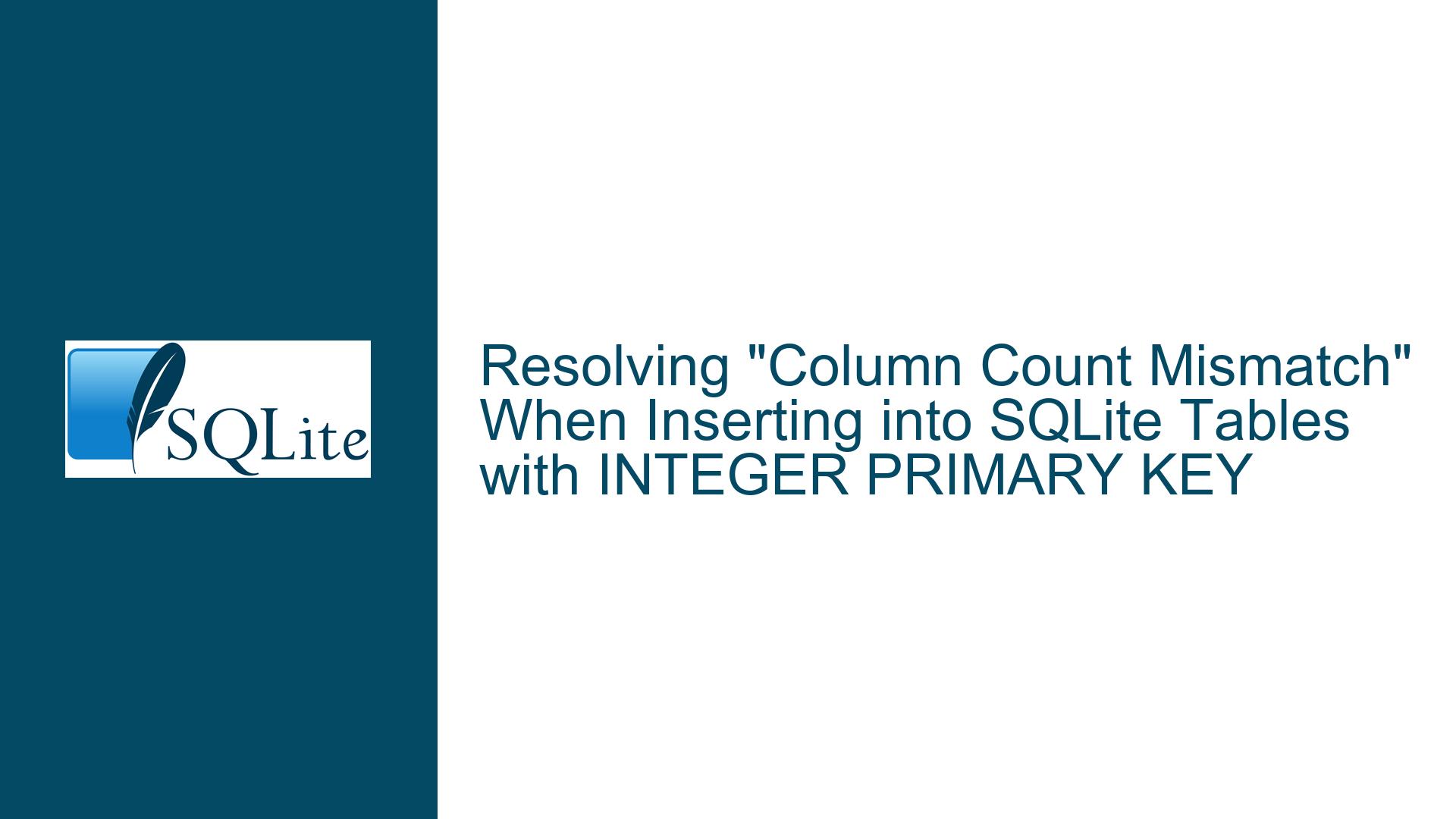Resolving “Column Count Mismatch” When Inserting into SQLite Tables with INTEGER PRIMARY KEY
Issue Overview: Column Count Mismatch Due to Implicit vs. Explicit Column Definitions in INSERT Statements
A common error encountered when working with SQLite is the sqlite3.OperationalError: table X has Y columns but Z values were supplied exception. This occurs when the number of values provided in an INSERT statement does not match the number of columns defined in the target table. In the case discussed, the male_first_name table has two columns (idx and name), but the INSERT statements supply only one value. The root cause revolves around the interaction between SQLite’s handling of INTEGER PRIMARY KEY columns and the structure of INSERT statements.
The idx column is declared as INTEGER PRIMARY KEY, which in SQLite makes it an alias for the rowid system column. This column is automatically assigned a unique integer value if not explicitly provided during insertion. However, this behavior depends on whether the column is explicitly or implicitly omitted in the INSERT statement. If the INSERT does not specify column names and supplies fewer values than the total number of columns, SQLite interprets this as an attempt to insert into all columns, leading to a mismatch. The error arises from a misunderstanding of how SQLite handles default values for INTEGER PRIMARY KEY columns and the syntax requirements of INSERT statements.
The confusion often stems from conflating two distinct scenarios:
- Omitting the
INTEGER PRIMARY KEYcolumn by explicitly excluding it from the column list in theINSERTstatement. - Omitting the
INTEGER PRIMARY KEYcolumn by failing to account for its existence in theINSERTstatement’s value list when no column list is provided.
This issue highlights critical nuances in SQLite’s schema design, column constraints, and insertion syntax. Resolving it requires a detailed examination of how primary keys, default values, and insertion mechanics interact.
Possible Causes: Implicit Column Inclusion and INTEGER PRIMARY Key Auto-Population Rules
1. Implicit Column Inclusion in INSERT Statements Without Column Lists
When an INSERT statement does not explicitly list columns (e.g., INSERT INTO table VALUES (...)), SQLite assumes that values are being supplied for all columns in the order they were defined in the table schema. In the male_first_name table, the schema defines two columns: idx and name. An INSERT statement like INSERT INTO male_first_name VALUES('Aaron') supplies one value, but the table expects two. SQLite does not skip columns in this mode, even if they are auto-populated. The error occurs because the statement violates the column count requirement.
2. Misunderstanding INTEGER PRIMARY KEY Auto-Population Behavior
The INTEGER PRIMARY KEY column (idx in this case) is auto-populated only when:
- The column is explicitly omitted from the
INSERTstatement’s column list, or - The
INSERTstatement explicitly suppliesNULLfor the column.
For example:
INSERT INTO male_first_name (name) VALUES ('Aaron')omitsidx, so SQLite auto-populates it.INSERT INTO male_first_name VALUES (NULL, 'Aaron')suppliesNULLforidx, triggering auto-population.
If the INSERT statement neither omits idx from the column list nor supplies NULL, SQLite expects an explicit value for it. The error arises when the user assumes auto-population occurs even when the column is implicitly included via an incomplete value list.
3. Schema Mismatch Between Development and Production Environments
The user mentioned that the SQL file worked in another environment where the table had only one column (name). This indicates a schema discrepancy: the working environment’s table lacked the idx column. When the schema was modified to include idx as an INTEGER PRIMARY KEY, the existing INSERT statements became invalid because they were not updated to reflect the new column count. This underscores the importance of synchronizing schema changes across environments and scripts.
Troubleshooting Steps, Solutions & Fixes: Aligning INSERT Statements with Schema Requirements
Step 1: Analyze the Table Schema and INSERT Statement Structure
Retrieve the table schema using:
PRAGMA table_info(male_first_name);
This returns:
cid | name | type | notnull | dflt_value | pk
----|------|--------------|---------|------------|----
0 | idx | INTEGER | 0 | NULL | 1
1 | name | TEXT | 0 | NULL | 0
The output confirms the table has two columns. Any INSERT statement without a column list must supply two values.
Step 2: Modify INSERT Statements to Explicitly Omit the INTEGER PRIMARY KEY Column
Rewrite the INSERT statements to exclude idx by specifying the target column(s):
INSERT INTO male_first_name (name) VALUES ('Aaron');
This explicitly tells SQLite to insert into the name column only, allowing idx to auto-populate.
Step 3: Use NULL to Trigger Auto-Population of INTEGER PRIMARY KEY
If avoiding column lists is preferred, supply NULL for the idx column:
INSERT INTO male_first_name VALUES (NULL, 'Aaron');
SQLite replaces NULL with the next available rowid value.
Step 4: Validate Schema Consistency Across Environments
Ensure all environments (development, testing, production) use the same schema version. Modify existing SQL scripts to reflect schema changes. For example, if a column is added, update INSERT statements to accommodate it via column lists or NULL placeholders.
Step 5: Test with Prepared Statements or ORM Configurations
If using an ORM (e.g., SQLAlchemy) or prepared statements, verify that model definitions match the database schema. For instance, a model mapped to male_first_name must include both idx and name attributes, with idx configured as an auto-incrementing primary key.
Step 6: Utilize SQLite’s RETURNING Clause for Debugging (SQLite 3.35+)
For modern SQLite versions, use the RETURNING clause to inspect auto-generated values:
INSERT INTO male_first_name (name) VALUES ('Aaron') RETURNING idx;
This returns the generated idx value, confirming successful auto-population.
Step 7: Implement Database Migrations with Version Control
Use migration tools (e.g., alembic, flyway) to track schema changes. When adding an INTEGER PRIMARY KEY column, generate a migration script that updates existing INSERT statements to use column lists or NULL placeholders.
By addressing the implicit inclusion of columns in INSERT statements, clarifying INTEGER PRIMARY KEY auto-population rules, and ensuring schema consistency, developers can resolve column count mismatches and maintain robust database operations.






